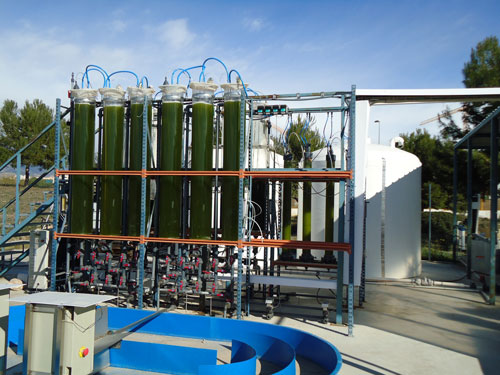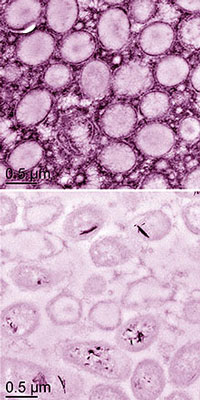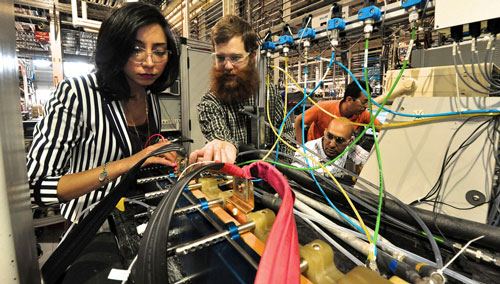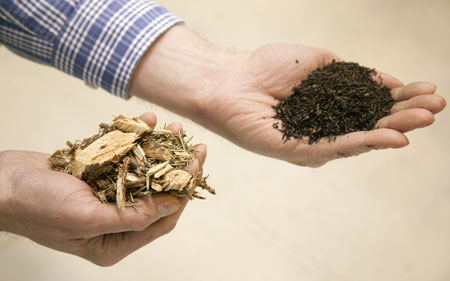Microwaves make for faster, greener pharma manufacturing
Microwave radiation could provide a faster, greener way to manufacture drugs, according to researchers at the University of Bradford.
May 30th, 2013
Read more
 Subscribe to our Cleantech News feed
Subscribe to our Cleantech News feed
Microwave radiation could provide a faster, greener way to manufacture drugs, according to researchers at the University of Bradford.
May 30th, 2013
Read more Directly removing CO2 from the air has the potential to alter the costs of climate change mitigation. It could allow prolonging greenhouse-gas emissions from sectors like transport that are difficult, thus expensive, to turn away from using fossil fuels. And it may help to constrain the financial burden on future generations.
Directly removing CO2 from the air has the potential to alter the costs of climate change mitigation. It could allow prolonging greenhouse-gas emissions from sectors like transport that are difficult, thus expensive, to turn away from using fossil fuels. And it may help to constrain the financial burden on future generations.
May 30th, 2013
Read moreThe TIBUCON project has developed a new-generation integrated heating, ventilation and air conditioning (HVAC) system suitable for larger multi-tenant buildings in particular.
May 29th, 2013
Read more A new version of solar cells created by laboratories at Rice and Pennsylvania State universities could open the door to research on a new class of solar energy devices.
A new version of solar cells created by laboratories at Rice and Pennsylvania State universities could open the door to research on a new class of solar energy devices.
May 29th, 2013
Read more Lawrence Livermore scientists have discovered and demonstrated a new technique to remove and store atmospheric carbon dioxide while generating carbon-negative hydrogen and producing alkalinity, which can be used to offset ocean acidification.
Lawrence Livermore scientists have discovered and demonstrated a new technique to remove and store atmospheric carbon dioxide while generating carbon-negative hydrogen and producing alkalinity, which can be used to offset ocean acidification.
May 28th, 2013
Read moreAs part of the Open Government initiative launched by the Obama Administration, Sandia National Laboratories' Technical Reference on Hydrogen Compatibility of Materials has made its debut on the Energy Dataset of OpenEnergyInfo, or OpenEI.
May 28th, 2013
Read moreWind energy capacity is growing rapidly in the cold climates of the world. According to the latest forecasts, between 45 and 50 gigawatts of wind energy will be built in cold climates by 2017, which would mean an increase of as much as 72 per cent since the end of 2012 and investments amounting to approximately EUR 75 billion.
May 28th, 2013
Read moreDroughts, floods, crop failures, invading species and diseases - climate change impacts of today and tomorrow come with a raft of buzz words. But the science behind our understanding of the potential consequences of global warming is both much broader and much more fragmented.
May 27th, 2013
Read more Researchers at the University of Alicante have patented a new device that allows more efficiently to cultivate microalgae and can be used as raw material for biofuel or for other valuable substances in the agri-food or pharmaceutical industry.
Researchers at the University of Alicante have patented a new device that allows more efficiently to cultivate microalgae and can be used as raw material for biofuel or for other valuable substances in the agri-food or pharmaceutical industry.
May 24th, 2013
Read moreThe mature and zero-carbon technology of geothermal power is being held back by the cost and uncertainty of drilling wells, but new research suggests a possible answer.
May 24th, 2013
Read morePakistan is one of the countries most vulnerable to climate change - risks range from the disastrous 2010 floodings that acted as a wake-up call to retreating glaciers impacting freshwater supply. To confront this challenge, the new Centre for Climate Research and Development (CCRD) took up its work this month - a substantial effort to build up indigenous scientific capacities in a place where substantial climate change impacts are actually happening.
May 24th, 2013
Read moreThe vision of a society in which each inhabitant of the earth manages to consume only 2000 watts has already been around for 15 years. During this time, there has been a steady increase in environmental awareness in the West. Technology has become more efficient and there appears to be very little standing in the way of a sustainable lifestyle. However, as a study by Empa and the Federal Institute of Technology (ETH) Zurich now shows, Mr and Mrs Swiss are still a long way from achieving this.
May 24th, 2013
Read more Bacteria can move electrons at least half a millimeter across a scaffolding made by themselves, of themselves, even under starving conditions. This new finding challenges conventional wisdom, which held that electrical resistance within bacterial biofilms - robust structures held together by a strong matrix - would restrict long-range electron transfer.
Bacteria can move electrons at least half a millimeter across a scaffolding made by themselves, of themselves, even under starving conditions. This new finding challenges conventional wisdom, which held that electrical resistance within bacterial biofilms - robust structures held together by a strong matrix - would restrict long-range electron transfer.
May 23rd, 2013
Read more Researchers working to improve durability in fuel cell powered buses have discovered links between electrode degradation processes and bus membrane durability. The team is quantifying the effects of electrode degradation stressors in the operating cycle of the bus on the membrane lifetime.
Researchers working to improve durability in fuel cell powered buses have discovered links between electrode degradation processes and bus membrane durability. The team is quantifying the effects of electrode degradation stressors in the operating cycle of the bus on the membrane lifetime.
May 22nd, 2013
Read moreThe discovery of potential environmental and human health effects from disposal of millions of rechargeable lithium-ion batteries each year has led scientists to recommend stronger government policies to encourage recovery, recycling and reuse of lithium-ion (Li-ion) battery materials.
May 22nd, 2013
Read moreGround-breaking Australian research on the viability of aviation biofuels has today been released, at the culmination of almost three years of work.
May 22nd, 2013
Read more Berkeley Lab spin-off company PolyPlus has created an entire line of lithium-metal batteries using their PLE technology.
Berkeley Lab spin-off company PolyPlus has created an entire line of lithium-metal batteries using their PLE technology.
May 22nd, 2013
Read more Tops and branches from tree-felling sites are reborn in the laboratory as compact pellets. However, the energy industry will not act until the price is right.
Tops and branches from tree-felling sites are reborn in the laboratory as compact pellets. However, the energy industry will not act until the price is right.
May 22nd, 2013
Read more